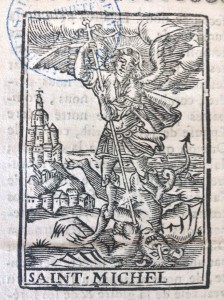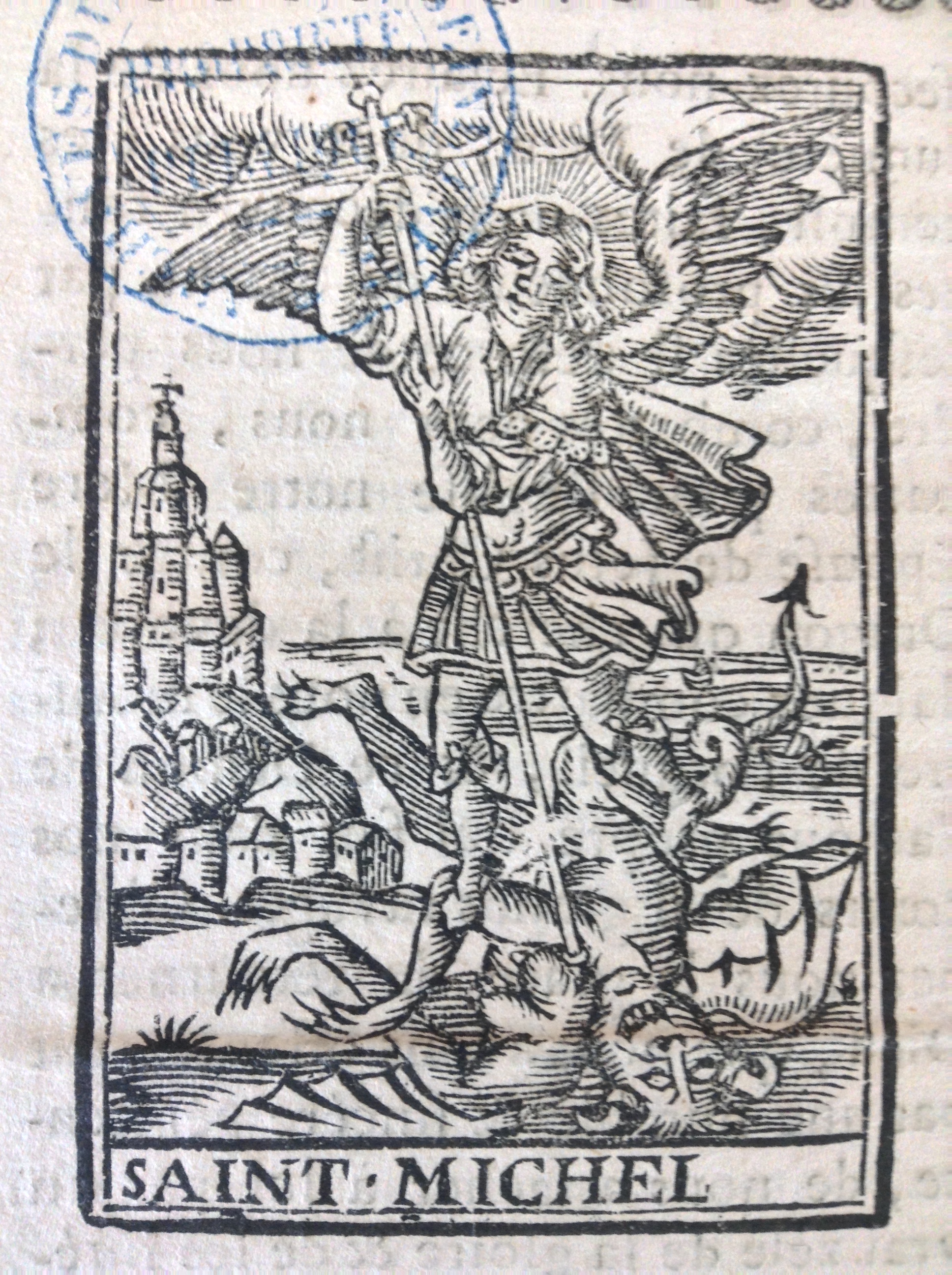BY ELIZABETH TINGLE
The abbey of the Mont Saint-Michel is located on a spectacular natural site, a small rocky outcrop in the bay of Avranches in Normandy which is an island at high tide but accessible on foot at low tide. In 708 AD, Aubert, bishop of Avranches, founded a sanctuary on the Mont following dream-revelations of the Archangel Michael. As St Michael came to play a central role in judging souls after death after 1100, the Mont attracted pilgrims who sought his assistance.
While the pilgrimage declined during the Reformation and religious wars of the sixteenth century, it revived again enormously after 1600. It was only from the mid- eighteenth century that numbers fell away. With the Counter Reformation, the monastic community made great effort to attract pilgrims, to cater to their changing spiritual tastes and to contribute to the Catholic Reform ‘project’ of the salvation of souls. The result was a revival of ‘heroic journeys’ to the Mont.
 The revival of pilgrimage in Europe in the later sixteenth century had a number of causes. It was a result of the Council of Trent’s confirmation of the importance of saints’ cults from 1563; the great Roman jubilee of 1575 and the re-adoption of traditional devotional activities by an increasingly confident and militant Catholic Church eager to revive the faith and to thwart Protestantism. But it was not simply a matter of the resurrection of old practices; many of the ‘medieval’ features of pilgrimage changed.
The revival of pilgrimage in Europe in the later sixteenth century had a number of causes. It was a result of the Council of Trent’s confirmation of the importance of saints’ cults from 1563; the great Roman jubilee of 1575 and the re-adoption of traditional devotional activities by an increasingly confident and militant Catholic Church eager to revive the faith and to thwart Protestantism. But it was not simply a matter of the resurrection of old practices; many of the ‘medieval’ features of pilgrimage changed.
There was a greater localisation of shrines and religious life in general, based on the parish or neighbourhood; there was growing stress on interior pilgrimage, as a spiritual rather than a physical activity; dedications to universal saints – principally Mary – expanded at the expense of older cults and there was a decrease in individual pilgrimage and a rise in collective journeys. In sum, historians have found a greater localization and collectivization of religious life, under closer control of clergy. The classic pilgrimages to the great medieval shrines were assumed to have declined.
Yet it is clear from contemporary sources that long-distance pilgrimage to the classic sites such as Rome, Loreto, Santiago de Compostela and others, persisted. The central question of my current research project is therefore how ancient, distant religious shines reinvented themselves in the early modern period to attract pilgrims: how did they make themselves relevant to the changing priorities of post-medieval Catholicism and assist in its dissemination? What did such sites offer the pilgrim that local shrines and other religious traditions did not?
A good example of the role of such institutions in mediating counter-reformation ideals into lived practices is that of the most famous of the medieval shrines, the Mont Saint-Michel. Here, the monks modernised its spiritual attractions and capitalised on its extra-ordinary physical site to offer devotional experiences that could not be gained in local communities.
The revival of the pilgrimage at the Mont after 1600 was the result of a careful campaign by the abbey, where the monastic community encouraged pilgrimage as a bulwark against heresy and moved the focus of pilgrims’ activities towards the sacramental and the pedagogic. The abbey used four main tactics: promoting the cult of St Michael as a bulwark against Protestant heresy; augmenting the theatre and quality of the liturgy at the site, particularly the eucharist; offering new plenary indulgences, and through sermons and publications for pilgrims.
But although Church authorities attempted to direct and supervise pilgrimage piety, the response was firmly in the hands of the population. ‘Ordinary’ Catholics, whether as an individual or in community, controlled pilgrimage because it was they who determined the relative popularity of shrines. Pilgrimage was a demand-led activity for which there was increasing competition in the Counter Reformation. The response of pilgrims to the Mont Saint-Michel’s ‘offer’ was therefore crucial: the success of the pilgrimage stemmed from the fact that people came.
In the post-Reformation pilgrimage to the Mont, two cultural factors stand out: its adoption by confraternities and its relationship to aspects of male religious culture. Both of these saw the shrine promoted in local communities and encouraged many people to make the pilgrimage.
The fundamental objectives of Catholic reformers were the conversion of the sinner and his or her spiritual movement towards God, through the sacraments and prayer. The means for much of this was available in parishes or at local shrines. But the great, traditional, distant centres of pilgrimage also contributed to the devotional culture of individuals and groups who wanted to go beyond the local, to experience a challenge as part of their spiritual, cultural and social growth.
At the Mont Saint-Michel, the revival and persistence of the shrine from the later 16th century came from the universality of the cult of St Michael, his role in the struggle against heresy, and veneration tied increasingly to that of Christ through the Eucharist. While pilgrims continued to travel in search of, or in thanksgiving for, healing and other graces, there was also a greater emphasis on spiritual healing and intimacy with God. Also, for many young men, they proved themselves and their Catholicity by undertaking this heroic journey, which was not without peril. Motives also included indulgences and the splendour of the site itself, as natural wonder. It was worth travelling to experience these things.
Through the pilgrimage to the Mont, reformed Catholicism spread many of its ideas and values around the cities and communities of northern France. Papal prestige was strengthened through the pilgrim’s experience of indulgences at the shrine. Encouragement of the pilgrimage through printed pamphlets and handbooks, also promoted new-style devotions and prayers, for the real and virtual pilgrim.
Thus, the medieval pilgrimage to the Mont was re-invented and re-fashioned to act as a vector of Tridentine influences and devotions, which were taken back into local communities. The Mont pilgrimage acted as a node in the intellectual and geographical translation of changing spiritual practices and devotions in the French Counter Reformation as indeed the Compostelan pilgrimage has done today.
About the author:
 Elizabeth Tingle is Professor of Early Modern European History and Head of the School of Humanities & Performing Arts at Plymouth University. In March 2016, she takes up a new post at De Montfort University. Her books include: Authority and Society in Nantes during the French Wars of Religion 1558-1598 (2006); Purgatory and Piety in early modern Brittany 1480-1720 (2012); Dying, Death, Burial and Commemoration in Reformation and Counter-Reformation Britain and Europe (edited with Jonathan Willis, 2015); and Indulgences after Luther: the fall and rise of pardons in France 1500-1700 (2015).
Elizabeth Tingle is Professor of Early Modern European History and Head of the School of Humanities & Performing Arts at Plymouth University. In March 2016, she takes up a new post at De Montfort University. Her books include: Authority and Society in Nantes during the French Wars of Religion 1558-1598 (2006); Purgatory and Piety in early modern Brittany 1480-1720 (2012); Dying, Death, Burial and Commemoration in Reformation and Counter-Reformation Britain and Europe (edited with Jonathan Willis, 2015); and Indulgences after Luther: the fall and rise of pardons in France 1500-1700 (2015).

